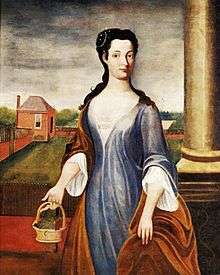William Dering
William Dering (active between 1735 and 1751) was an American dancing master and painter active primarily in Virginia. Very little is known about his life or career; what few details have been established are known primarily from newspaper advertisements, court records, journal entries, and ledgers and from his few surviving paintings.[1]

Life
Dering is first recorded as a dancing master in Philadelphia, Pennsylvania, from 1735 to 1736. A good conversationalist, he is said to have been respected as well for his talents on the French horn;[2] his school also offered lessons in "Reading, Writing, Dancing, Plain Work, Marking, Embroidery, and several other Works: where Likewise young Ladies and Gentlemen may be instructed in the French."[3][4] He was likely still in Philadelphia in May of the next year, when local papers advertised the loss of his horse.[4] Dering had moved to Gloucester County, Virginia by 1737.[1] With his wife Sarah, he was present on October 8, 1738 at the baptism of their son, also named William, at Abingdon Church.[4]
Dering is next found in Williamsburg, Virginia, where he moved in 1742[1] and continued as a dancing master, opening a school at the College of William and Mary "where all Gentlemens Sons may be taught Dancing, according to the newest French Manner, on Fridays and Saturdays once in Three Weeks";[3][2][5] he seems to have taken up portrait painting sometime in the mid-1740s.[6] What caused the decision is unknown, although it has been suggested that the return of painter Charles Bridges to England may have served as a prompt;[6] indeed, it has been surmised by some that Dering purchased painting supplies from Bridges prior to the latter's departure.[7] Dering purchased a house from Henry Cary II, the Brush-Everard House,[8] on the Palace Green, near the Governor's Palace;[1] it survives today, preserved by the Colonial Williamsburg Foundation.[8]
Dering is known to have been acquainted with members of some of the more important families in Virginia society; William Byrd II, in his diaries, records many visits by the dancing master to Westover Plantation in 1740 and 1741, and in the latter year records a visit to Henry Cary II at Ampthill,[3] at which Dering was present.[2] The nature of the men's professional relationship is unknown, due to the cryptic nature of the diary; Byrd does mention a visit during which he showed Dering some prints, suggesting that Dering may have come to Westover in furtherance of his artistic pursuits.[7] During another visit he is recorded as having played the French horn.[4]
Dering continued in his primary career, arranging balls and assemblies in Williamsburg at least through the spring of 1747.[6] However, he was plagued with debts and other legal issues throughout his time in the town,[2] and as early as 1739 is recorded as a party in numerous lawsuits from residents of Williamsburg and Gloucester and York counties.[1] Furthermore, inventories of his heavily-mortgaged house reveal a surprisingly lavish lifestyle for a person of his profession.[4] Dering had left Williamsburg by December, 1749, heading to Charleston, South Carolina, where he was last recorded with certainty in 1751.[6] He had left his wife behind to settle his debts and auction off the couple's belongings; it is possible that she took in boarders as well.[2]
Documentary references to a William Dering being active in Charleston in 1764 have been found; some scholars, believing the two to be one and the same, have suggested a link between the dancing master and the earlier pastelist Henrietta Johnston (whose first marriage was to a man named Dering), who lived in that city until her death. Others believe the link to be dubious at best.[6]
Work
Fewer than a dozen portraits attributed to Dering survive, suggesting that painting may have merely been a sideline and not a main source of income for him.[1] Only one is signed, that of Mrs. Drury Stith;[9] the others have been linked to him due to their stylistic similarity to this one.[6] His best-known work is a full-length portrait of George Booth of Gloucester County, dating to around 1745; it is currently in the collection of the Colonial Williamsburg Foundation, along with a portrait of his mother, Mrs. Mordecai Booth;[6] a portrait of Anne Byrd Carter;[10] and the portrait of Mrs. Stith.[9] It is recorded that Dering was possessed, in 1745, of "1 large hair Trunk with about 200 prints",[6] and his portraits, as with many others painted in the Colonies, suggest a knowledge of pose gleaned from English prints.[1] Most of his paintings have been described as "linear and flat", and they reveal a limited knowledge of technique.[4]
References
- Gerard C. Wertkin (2 August 2004). Encyclopedia of American Folk Art. Routledge. pp. 156–. ISBN 978-1-135-95615-8.
- Kate Van Winkle Keller (2007). Dance and Its Music in America, 1528–1789. Pendragon Press. pp. 203–. ISBN 978-1-57647-127-2.
- "Digital Library – Colonial Williamsburg". history.org. Retrieved 20 March 2015.
- Carol Crown; Cheryl Rivers; Charles Reagan Wilson (3 June 2013). The New Encyclopedia of Southern Culture: Volume 23: Folk Art. UNC Press Books. pp. 401–. ISBN 978-1-4696-0799-3.
- "Media". encyclopediavirginia.org. Retrieved 21 March 2015.
- Richard H. Saunders; Ellen Gross Miles; National Portrait Gallery (Smithsonian Institution) (1987). American colonial portraits, 1700–1776. Published by the Smithsonian Institution Press for the National Portrait Gallery. ISBN 978-0-87474-695-2.
- Margaret Beck Pritchard; Virginia Lascara Sites (1993). William Byrd II and His Lost History: Engravings of the Americas. Colonial Williamsburg. pp. 58–. ISBN 978-0-87935-088-8.
- "The Brush-Everard House". history.org. Retrieved 20 March 2015.
- "Elizabeth Buckner Stith 1700–1756". stithvalley.com. Retrieved 20 March 2015.
- "Media". encyclopediavirginia.org. Retrieved 21 March 2015.